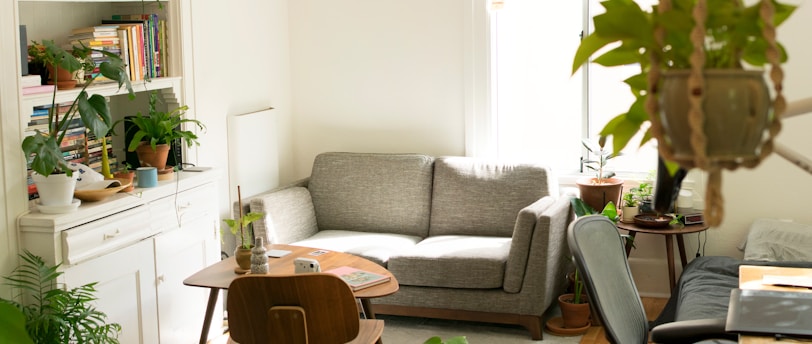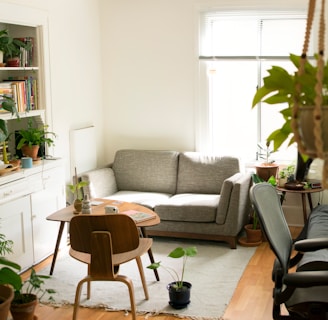Practical Ways to Make Small Spaces Look Big
Practical tips to make narrow spaces look large and spacious! Discover decorating tips to make small spaces look bigger with lighting, furniture selection and color usage.
HOME & DECORATION
2/24/20254 min read


Understanding the Psychology of Space
Our perception of space profoundly influences our emotions and mental well-being. Small spaces can often evoke feelings of confinement or discomfort, impacting our overall mood. The psychological effects of small spaces vary depending on personal experiences and cultural backgrounds; however, the common thread remains that the design and layout of our environments play a crucial role in shaping our perceptions. Understanding the psychology behind spatial perception can help in creating a more comfortable living environment.
One effective way to create the illusion of a larger space is through strategic use of color. Light, neutral colors tend to reflect more light than darker hues, which helps in making a room appear more expansive. For instance, shades like white, beige, or pastel colors can open up a space visually, offering a calming effect. Additionally, utilizing a monochromatic color palette can unify the room, further enhancing the sense of space.
Lighting is another critical factor that impacts our perception of space. Bright, natural light can amplify the feeling of openness. Incorporating mirrors or reflective surfaces can also create an illusion of depth while drawing in more light. Carefully placed lighting fixtures can highlight particular areas, directing the eye and creating focal points that make the surroundings feel larger. Good design considers the interplay of light and shadow, helping to dispel the constraints often associated with small spaces.
The spatial layout is equally essential in managing how we perceive our surroundings. An open floor plan with minimal barriers can foster a sense of continuity, while furniture placement should promote easy movement flow. This will not only make a room more functional but also enhance the overall perception of space. Assessing your own space and the emotions it evokes can lead to insightful decisions about necessary changes to achieve a welcoming and open atmosphere.
Strategic Lighting Techniques
Lighting is an essential element in interior design, especially when it comes to making small spaces appear larger and more inviting. The strategic use of various lighting types such as ambient, task, and accent lighting can significantly enhance spatial perception. Ambient lighting serves as the primary source of illumination, creating a base layer of light that fills the room. Utilizing overhead fixtures, sconces, or even floor lamps can establish a sense of openness. Ensuring that ambient lighting is bright enough while also being evenly distributed is crucial for achieving an airy feel.
Task lighting, which focuses on specific areas for activities like reading, cooking, or working, is another critical component. This type of lighting can include table lamps, under-cabinet lights, and even pendant fixtures above countertops. By layering task lighting into the overall scheme, one can create functionality without dominating the visual space. It’s recommended to select fixtures that are sleek and low-profile to prevent overwhelming the area.
Accent lighting, on the other hand, serves to highlight specific features or areas within your small space, such as artwork or architectural details. This can be accomplished through wall-mounted lights, picture lights, or small spotlights. Strategically placed accent lights can draw attention away from less desirable areas and create an illusion of depth. Furthermore, utilizing natural light to its fullest potential is paramount. This includes positioning mirrors across from windows to reflect light and opening up curtains to let sunlight stream in.
The impact of color temperature should not be overlooked. Opting for bulbs with a higher Kelvin rating can introduce a cooler, daylight effect, which often appears more spacious than warm light. Combining these lighting techniques can transform a confined space, making it appear larger, brighter, and more welcoming. With thoughtful planning and execution, strategic lighting can truly redefine the atmosphere of any small area.
Smart Furniture Choices
When it comes to maximizing small spaces, making informed furniture selections is paramount. Multi-functional furniture pieces can play a pivotal role in creating a sense of openness while providing necessary functionality. For instance, consider incorporating sofa beds into your living area. These versatile pieces serve dual purposes, functioning as both a cozy seating option during the day and a comfortable bed at night, effectively saving valuable floor space.
Another excellent choice is the extendable table. Ideal for dining areas that require flexibility, an extendable table can accommodate additional guests when needed and be contracted to save space when not in use. This adaptability allows for seamless transitions between everyday life and hosting gatherings, making it a practical addition to any small home.
Storage ottomans are also invaluable in small spaces. They not only serve as a footrest or additional seating but also provide hidden storage opportunities. Utilizing such pieces helps maintain organization while reducing visual clutter, which is crucial in a limited area. By selecting furniture that serves multiple functions, you can ensure that the space remains open and inviting.
Optimal arrangement of these pieces is just as significant as the choice of furniture. By placing larger items against walls and opting for lighter-colored materials, you can create visual depth, allowing your space to appear larger. Moreover, utilizing vertical storage options, such as wall-mounted shelves, helps to keep floor areas clear, facilitating better flow throughout the room.
Incorporating smart furniture choices with a focus on functionality and spatial efficiency will undoubtedly enhance the overall ambiance of small spaces, ensuring they remain practical without feeling cramped or overcrowded.
The Power of Color and Decor
Using color and decor strategically can significantly enhance the perception of space in small areas. Color theory plays a vital role in determining how colors affect mood and spatial awareness. Lighter shades tend to reflect light, making a room feel airy and expansive. Soft hues such as whites, creams, pastels, and light grays are excellent choices for walls and ceilings to create an illusion of spaciousness. On the other hand, darker colors can add depth but may make a small space feel more confined if not used judiciously.
When selecting flooring, opting for light-colored materials can also help enhance the feeling of openness. Continuity in color throughout the floor and walls creates an uninterrupted visual flow, further contributing to the illusion of a larger area. Additionally, incorporating reflective surfaces, such as mirrors and glossy finishes, can amplify light in the room and provide a visual expansion effect.
Decor plays a crucial role, too. Minimalistic decor can prevent the space from feeling cluttered and overwhelming. Avoid overcrowding surfaces with too many decorative items. Instead, focus on a few quality pieces that reflect your style and keep the overall look cohesive. Small patterns can add interest, but it is essential to balance them with solid colors to maintain a spacious feel. For instance, using patterned throw pillows on a solid-colored sofa can enliven a space without overwhelming it.
Finally, strategic placement of decor items is key. Elevating objects off the floor—using shelves or wall-mounted pieces—can create the illusion of height, contributing to an airy atmosphere. Emphasizing vertical lines through decor can lead the eye upward, further enhancing the sense of space.
Quick Menu
Confidence
© 2024. All rights reserved.
